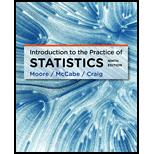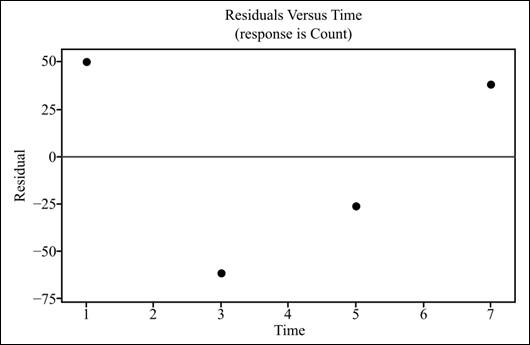
Concept explainers
(a)
To find: The four residuals for the data provided on the counts over different times.
(a)
Answer to Problem 96E
Solution: The residuals for the four counts are obtained as
Explanation of Solution
Calculation: The regression equation for the provided data set is as follows:
Here, the response variable
For time
For time
For time
For time
The observed
The residuals (represented as
For
For
For
For
Hence, the four residuals obtained are
(b)
To graph: The model for residual versus time plot.
(b)
Explanation of Solution
Graph: The residual versus time plot is obtained using the Minitab software by following the steps below:
Step 1: Enter the data in the Minitab worksheet.
Step 2: Go to Stat and select Regression and then select Regression again.
Step 3: Enter the response variable as ‘Count’ and Predictors as ‘Time.’
Step 4: Under Graphs option, choose Residuals versus order.
Step 5: Fill in Residual versus the variables as ‘Time.’
Step 6: Click on Ok.
The resultant graph is obtained as follows:

(c)
To explain: Interpretation of the obtained residual plot.
(c)
Answer to Problem 96E
Solution: Since there is no pattern observed in the residuals versus time plot, it can be concluded that the provided model is appropriate to estimate the count variable.
Explanation of Solution
Want to see more full solutions like this?
Chapter 2 Solutions
Introduction to the Practice of Statistics
 MATLAB: An Introduction with ApplicationsStatisticsISBN:9781119256830Author:Amos GilatPublisher:John Wiley & Sons Inc
MATLAB: An Introduction with ApplicationsStatisticsISBN:9781119256830Author:Amos GilatPublisher:John Wiley & Sons Inc Probability and Statistics for Engineering and th...StatisticsISBN:9781305251809Author:Jay L. DevorePublisher:Cengage Learning
Probability and Statistics for Engineering and th...StatisticsISBN:9781305251809Author:Jay L. DevorePublisher:Cengage Learning Statistics for The Behavioral Sciences (MindTap C...StatisticsISBN:9781305504912Author:Frederick J Gravetter, Larry B. WallnauPublisher:Cengage Learning
Statistics for The Behavioral Sciences (MindTap C...StatisticsISBN:9781305504912Author:Frederick J Gravetter, Larry B. WallnauPublisher:Cengage Learning Elementary Statistics: Picturing the World (7th E...StatisticsISBN:9780134683416Author:Ron Larson, Betsy FarberPublisher:PEARSON
Elementary Statistics: Picturing the World (7th E...StatisticsISBN:9780134683416Author:Ron Larson, Betsy FarberPublisher:PEARSON The Basic Practice of StatisticsStatisticsISBN:9781319042578Author:David S. Moore, William I. Notz, Michael A. FlignerPublisher:W. H. Freeman
The Basic Practice of StatisticsStatisticsISBN:9781319042578Author:David S. Moore, William I. Notz, Michael A. FlignerPublisher:W. H. Freeman Introduction to the Practice of StatisticsStatisticsISBN:9781319013387Author:David S. Moore, George P. McCabe, Bruce A. CraigPublisher:W. H. Freeman
Introduction to the Practice of StatisticsStatisticsISBN:9781319013387Author:David S. Moore, George P. McCabe, Bruce A. CraigPublisher:W. H. Freeman





